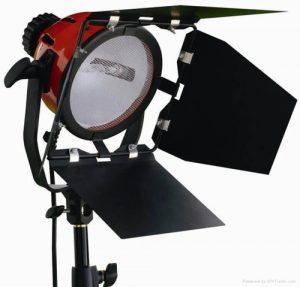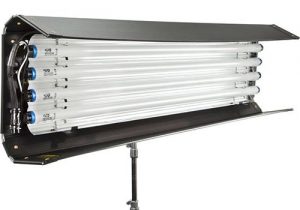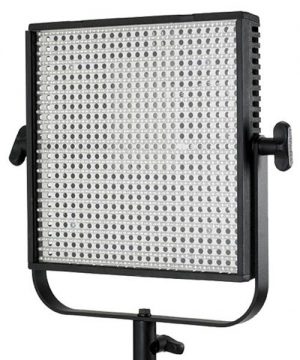 Welcome to the first in a series of articles looking at the many types of lighting instruments in use on film and TV sets today. This is not intended to be an exhaustive or comprehensive list, but it will give you a good idea of your options, particularly if you’re moving up from smaller productions – where lighting kit is mostly borrowed – to larger ones, where you’re required to submit a lighting list to a rental house.
Welcome to the first in a series of articles looking at the many types of lighting instruments in use on film and TV sets today. This is not intended to be an exhaustive or comprehensive list, but it will give you a good idea of your options, particularly if you’re moving up from smaller productions – where lighting kit is mostly borrowed – to larger ones, where you’re required to submit a lighting list to a rental house.
Some of the key considerations when choosing a lamp are:
- Colour temperature – how orange or blue the light appears – see this post for more info
- CRI – Colour Rendering Index – how full a spectrum of light is emitted, and therefore how accurately colours are rendered
- Light quality – how hard or soft the light is
- Power consumption
- Hire (rental) cost
Lamps can be divided into categories according to the means by which they produce light. Here is an overview of the main types.
Incandescent/Tungsten (view detailed post)
 Incandescent lamps work by passing electrical current through a wire filament which becomes so hot that it glows. In the film industry they are generally referred to as ‘tungsten‘ units after the metal which the filament is made from. Common tungsten lamps include Dedolites, 1K ‘babies’ and open-face 800W and 2KW units (which have misogynous nicknames I shall not repeat here).
Incandescent lamps work by passing electrical current through a wire filament which becomes so hot that it glows. In the film industry they are generally referred to as ‘tungsten‘ units after the metal which the filament is made from. Common tungsten lamps include Dedolites, 1K ‘babies’ and open-face 800W and 2KW units (which have misogynous nicknames I shall not repeat here).
Pros: cheap, dimmable, extremely high CRI
Cons: very inefficient, get very hot, colour temperature changes when dimmed
Colour temperature: 3,200K
Light quality: generally hard (although certain units like Space Lights are softer)
HMI (view detailed post)
 The HMI (hydragyrum medium-arc iodide) is the most common form of high intensity discharge lamp used in the industry. It operates by creating an electrical arc between two electrodes which excites a gas. You may occasionally hear about an MSR (medium source rare-earth), which is slightly different technology, but as far as a cinematographer is concerned MSRs and HMIs are the same. They require a ballast to ignite the arc and regulate the current and voltage.
The HMI (hydragyrum medium-arc iodide) is the most common form of high intensity discharge lamp used in the industry. It operates by creating an electrical arc between two electrodes which excites a gas. You may occasionally hear about an MSR (medium source rare-earth), which is slightly different technology, but as far as a cinematographer is concerned MSRs and HMIs are the same. They require a ballast to ignite the arc and regulate the current and voltage.
Pros: good CRI, good match for daylight, efficient
Cons: only dimmable down to 50%, expensive, heads and ballasts sometimes hum or ‘squeal’, older bulbs can vary in colour, flicker issues at certain shutter angles with magnetic ballasts
Colour temperature: 5,600K
Light quality: hard
Fluorescent (view detailed post)
 Fluorescent lamps are found almost everywhere today, as strip lights in supermarkets and offices, and energy-saver bulbs in the home. Similar in principle to HMIs, electric current causes mercury vapour to emit UV light which is translated into the visible spectrum by the phosphor coating on the tube. Kino Flo pretty much has the monopoly on fluorescent lighting for the film industry. Like HMIs, fluorescents require a ballast.
Fluorescent lamps are found almost everywhere today, as strip lights in supermarkets and offices, and energy-saver bulbs in the home. Similar in principle to HMIs, electric current causes mercury vapour to emit UV light which is translated into the visible spectrum by the phosphor coating on the tube. Kino Flo pretty much has the monopoly on fluorescent lighting for the film industry. Like HMIs, fluorescents require a ballast.
Pros: reasonable CRI from Kino Flos (appalling CRI from domestic/commercial fixtures), very efficient, get warm but not hot
Cons: limited dimming, high fall-off of light
Colour temperature: 5,500K and 3,200K tubes available
Light quality: soft
LED (view detailed post)
 Gradually replacing tungsten as the most common lamps found on no-budget shoots, LED (light emitting diode) units contain semi-conductors that emit light when their electrons reconfigure. The technology is advancing rapidly, but there is currently a wide range of LED lamps on the market, varying greatly in price and corresponding quality.
Gradually replacing tungsten as the most common lamps found on no-budget shoots, LED (light emitting diode) units contain semi-conductors that emit light when their electrons reconfigure. The technology is advancing rapidly, but there is currently a wide range of LED lamps on the market, varying greatly in price and corresponding quality.
Pros: extremely efficient, barely get warm, can run off batteries, almost fully dimmable, some models have adjustable colour temperature
Cons: CRI ranges from almost acceptable in the expensive models to downright shocking in the cheaper ones
Colour temperature: varies
Light quality: varies
Though there are other types of lighting, like xenon, metal-halide and HEP (high efficiency plasma), the above four are the main ones you will encounter on film and TV sets today. Over the next few weeks I’ll look at each of those types in more detail, listing many of the specific units available in each category and their applications.
By the way, if your budget is too tight to hire film lamps of any kind, you may want to check out my post on lighting without movie lamps.
—
This article originated at www.neiloseman.com . Check out Neil's other cinematographic articles there.

Trackbacks/Pingbacks